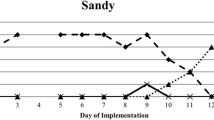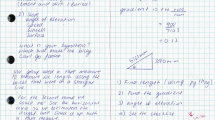Abstract
Integrated STEM education leverages interconnections between science, technology, engineering, and mathematics in order to reflect upon how each discipline operates within real world contexts. Students benefit from the integrated STEM approach because it values the real-life experiences of students along with the hands-on applications that mirror professional STEM work. Nevertheless, integrated STEM instruction remains ill-defined with many gaps evident in the existing research of how implementation explicitly works. The school setting central to this case study was a suburban public middle school that had sustained an integrated STEM program for a period of over 5 years. Through the use of phenomenological qualitative inquiry, we focused on both teachers’ and students’ experiences of participation in one integrated STEM model. Three major themes emerged as part of this inquiry. First, teachers engaged in continual reflection that along with district supports contributed to the durability of the model. Second, teachers and student engaged in dynamic learning transactions based on the particular task and concept covered. Third, science projects anchored learning opportunities deemed most successful by participants.

Similar content being viewed by others
References
Anderson, C. W., Holland, J. D. & Palincsar, A. S. (1997). Canonical and sociocultural approaches to research and reform in science education: The story of Juan and his group. The Elementary School Journa l, 91(4), 359–383.
Beane, J. (1991). The middle school: The natural home of integrated curriculum. Educational Leadership, 49(2), 9–13.
Beane, J. A. (1995). Curriculum integration and the disciplines of knowledge. Phi Delta Kappan, 76(8), 616–622.
Biesta, G. (2006). Beyond learning: Democratic education for a human future. Boulder, CO: Paradigm Publishers.
Black, P., & Wiliam, D. (2010). Inside the black box: Raising standards through classroom assessment. Phi Delta Kappan, 92(1), 81–90. https://doi.org/10.1177/003172171009200119.
Bransford, J. D., Brown, A. L., & Cocking, R. R. (2000). How people learn: Brain, mind, experience, and school. In J. D. Bransford, A. L. Brown, & R. R. Cocking (Eds.), Committee on learning research and educational practice (p. 385). Washington, DC: National Academies Press. https://doi.org/10.17226/9853.
Bybee, R. W. (2010). Advancing STEM education: A 2020 vision. Technology and Engineering Teacher, 70, 30–35.
Contant, T. L., Bass, J. L., Tweed, A. A., & Carin, A. A. (2017). Teaching science through inquiry-based instruction. New York, NY: Pearson.
Creswell, J. W., & Clark, V. L. P. (2007). Designing and conducting mixed methods research. Thousand Oaks, CA: Sage Publications.
Fensham, P. J. (2009). Real world contexts in PISA science: Implications for context based science education. Journal of Research in Science Teaching, 46(8), 884–896.
Ford, D. R. (2015). Pedagogy, social transformation, and space: Toward a revolutionary critical pedagogy for space (Doctoral dissertation). Retrieved from ProQuest.
Garza, G. (2011). Thematic collation: An illustrative analysis of the experience of regret. Qualitative Research in Psychology, 8(1), 40–65. https://doi.org/10.1080/14780880903490839.
Guzey, S. S., Moore, T. J., & Morse G. (2016). Student interest in engineering design-based science. School Science and Mathematics, 116(8), 411–419.
Heritage, M., & Heritage, J. (2013). Teacher questioning: The epicenter of instruction and assessment. Applied Measurement in Education, 26(3), 176–190. https://doi.org/10.1080/08957347.2013.793190.
Herro, D. & Quigley, C. (2016). Exploring teachers’ perspectives of STEAM teaching: Implications for practice. Prof Dev Educ (under review).
Keefe, B. (2009). The perception of STEM: Analysis, issues and future directions. Entertainment and Media Communication Institute, Division of Entertainment Industries Council, Inc. (EIC). Burbank, CA: EIC.
Kozoll, R. H., & Osborne, M. D. (2004). Finding meaning in science: Lifeworld, identity, and self. Science Education, 88(2), 157–181. https://doi.org/10.1002/sce.10108.
Lehesvuori, S., Viiri, J., & Rasku-Puttonen, H. (2011). Introducing dialogic teaching to science student teachers. Journal of Science Teacher Education, 22(8), 705–727. https://doi.org/10.1007/s10972-011-9253-0.
Lemke, J. L. (1990). Talking science: Language, learning, and values. Norwood, NJ: Ablex Publishing Corporation.
Morse, J. M., Barrett, M., Mayan, M., Olson, K., & Spiers, J. (2002). Verification strategies for establishing reliability and validity in qualitative research. International Journal of Qualitative Methods, 1(2), 13–22.
National Research Council. (2014). STEM integration in K-12 education: Status, prospects, and an agenda for research. Washington, DC: The National Academies Press. https://doi.org/10.17226/18612.
Patton, M. Q. (1990). Qualitative evaluation and research methods. Newbury Park, CA: SAGE Publications.
Peshkin, A. (1988). In search of subjectivity—one’s own. Educational Researcher, 17(7), 17–21.
Price, J. F., & McNeill, K. L. (2013). Toward a lived science curriculum in intersecting figured worlds: An exploration of individual meanings in science education. Journal of Research in Science Teaching, 50(5), 501–552.
Rich, Y., & Almozlino, M. (1999). Educational goal preferences among novice and veteran teachers of sciences and humanities. Teaching and Teacher Education, 15(6), 613–629.
Rowan, B., Correnti, R. & Miller, R. J. (2002). What large-scale, survey research tells us about teacher effects on student achievement: Insights from the prospects study of elementary schools (CPRE Research Report Series RR-051). Philadelphia, PA: Consortium for Policy Research in Education.
Venville, G. J., Wallace, J., Rennie, L. J., & Malone, J. A. (2002). Curriculum integration: Eroding the high ground of science as a school subject? Studies in Science Education, 37, 43–84.
Wang, H. H., Moore, T. J., Roehrig, G. H., & Park, M. S. (2011). STEM integration: Teacher perceptions and practice. Journal of Pre-College Engineering Education Research (J-PEER), 1(2), 2–13. https://doi.org/10.5703/1288284314636.
Author information
Authors and Affiliations
Corresponding author
Electronic supplementary material
ESM 1
(PDF 48 kb)
Rights and permissions
About this article
Cite this article
Gardner, M., Tillotson, J.W. Interpreting Integrated STEM: Sustaining Pedagogical Innovation Within a Public Middle School Context. Int J of Sci and Math Educ 17, 1283–1300 (2019). https://doi.org/10.1007/s10763-018-9927-6
Received:
Accepted:
Published:
Issue Date:
DOI: https://doi.org/10.1007/s10763-018-9927-6




